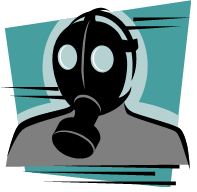The Smoke Gets in Your Eyes (and lungs)!
 You may have noticed it gets hot during the summer in Sacramento–and the rest of interior California. For the most part, you can adapt to running in the warmer weather.
You may have noticed it gets hot during the summer in Sacramento–and the rest of interior California. For the most part, you can adapt to running in the warmer weather.
It gets more challenging when the air is still, or there are wildfires upwind, and the air quality in the Valley begins to degrade.
This summer, we’ve been fortunate to have so few bad air days–with only a handful of Spare the Air Days, so far.
What, exactly, is air pollution and what does it mean for me?
There are two main constituents of air pollution that should be of concern to you as you plan your runs. These are ground level ozone and particulates.
Ozone is created when sunlight reacts with other chemical pollutants in the air.
Particulates are caused by everything from construction related dust to wildfires. The most dangerous of the particulates are the tiny ones, known as PM2.5. (i.e., particles 2.5 microns* or smaller) and PM10 (particles between 2.5 and 10 microns in diameter). In the Valley, these are mostly caused by combustion–motor vehicles and wildfires.
These smaller particles and ozone can nestle deep into your lungs and have lasting negative health impacts.
As a runner, how might these pollutants affect you?
Particle pollution – especially fine particles – contains microscopic solids or liquid droplets that are so small that they can get deep into the lungs and cause serious health problems. Numerous scientific studies have linked particle pollution exposure to a variety of problems, including:
- premature death in people with heart or lung disease,
- nonfatal heart attacks,
- irregular heartbeat,
- aggravated asthma,
- decreased lung function, and
- increased respiratory symptoms, such as irritation of the airways, coughing or difficulty breathing.
People with heart or lung diseases, children and older adults are the most likely to be affected by particle pollution exposure. However, even if you are healthy, you may experience temporary symptoms from exposure to elevated levels of particle pollution.
With regard to ozone, the US EPA says this:
Breathing ozone can trigger a variety of health problems including chest pain, coughing, throat irritation, and congestion. It can worsen bronchitis, emphysema, and asthma. Ground level ozone also can reduce lung function and inflame the linings of the lungs. Repeated exposure may permanently scar lung tissue.
Be sure to notice the word “permanently” in that last sentence.
So, how do you know what the current air pollution conditions are? Unlike smoke and particulates, ozone is generally invisible so we can even have high ozone levels on a clear and sunny day.
Fortunately for you, there is a handy website (Sparetheair.com) that is just packed with useful air quality information for the Sacramento Region.
You can find information on current conditions here. Living in the Valley, you would be wise to check there regularly during the hot days of summer and also the windless, foggy days of winter. Even if you miss a workout from time to time, or are forced to run indoors on the dreadmill, you’ll be happier and healthier in the long-run.
And after all, it’s the long run that really matters.
———————————–
*In case you are wondering, a micron is 1/1000 of a millimeter (mm). Since a dime is a little more than one millimeter thick (1.3mm according to the US Mint), a stack of 100 PM10 particles would be almost as tall as a dime.
It should also be pointed out that if you can stack up 100 PM10 particles, you have very tiny hands.
